

 中文摘要:
中文摘要:
为了开展燃烧流场数值模拟,构建了包含71个组分391个反应方程的正十四烷低温点火及燃烧骨架反应动力学机理(C14_SK71);采用计算奇异摄动法(CSP)和准稳态假设法(QSSA)对骨架机理进行简化,得到包含44个组分40个反应方程的总包简化机理(C14_Red44);通过实验测得的点火延迟时间、火焰传播速度以及射流搅拌反应器(JSR)组分浓度数据对机理进行了计算和验证。结果表明:该十四烷燃烧机理能够比较准确地预测温度700K~1350K内点火延迟数据,再现中低温条件下的负温度效应(NTC);较好地模拟了当量比0.7~1.4内的正十四烷/空气预混气的层流火焰传播速度,以及温度650K~1050K内正十四烷氧化过程中的组分分布。与现有的正十四烷氧化反应机理相比,该骨架机理和总包简化机理规模较小,为进一步开展燃烧流场数值模拟提供了可用的反应机理模型。
 英文摘要:
英文摘要:
In order to carry out combustion flow field simulation,a new skeletal mechanism for n-tetradecane(C14_SK71) containing 71 species and 371 reactions was constructed to describe low temperature ignition and combustion process. Through Computational Singular Perturbation(CSP) and Quasi Steady State Approximation(QSSA) reduction,a reduced mechanism(C14_Red44) consisting of 44 species and 40 reactions was obtained for this skeletal mechanism. The experimental ignition delay time,laminar flame speed and species profiles in Jet-Stirred Reactor(JSR) were simulated for skeletal and reduced mechanisms. It is demonstrated that the skeletal and reduced mechanisms were able to predict ignition delay time under temperature of 700K~1350K and reproduce the Negative Temperature Coefficient(NTC) in low to immediate temperature ranges.The laminar flame speed of premixed n-tetradecane/air with equivalence 0.7~1.4,and species profiles in JSR oxidation under temperature 650K~1050K were well simulated. Compared with the current detailed mechanisms in literature,the newly developed skeletal and reduced mechanisms are more compact and can be more easily applied into combustion flowfield simulations.
 同期刊论文项目
同期刊论文项目
 同项目期刊论文
同项目期刊论文
 期刊信息
期刊信息
